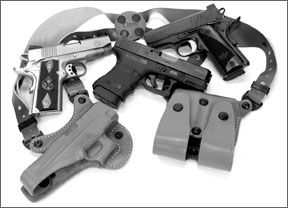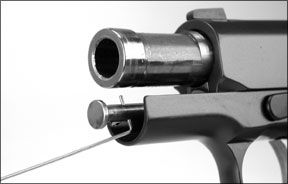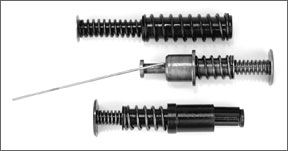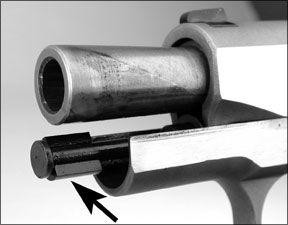In this evaluation of 45 ACP subcompacts, we’re going to ask how best to package the big bullet in a small concealable machine. We could say that our three test guns represent two-and-a-half interpretations of the subcompact pistol. That’s because our first two pistols, Kimber’s $1316 SIS Ultra and Springfield Armory’s $1031 Loaded Ultra Compact, are both small single-stack 1911s. But there are differences that set them apart. The third gun feeds from a high-capacity magazine with rounds compressed in a staggered column. Furthermore, ignition is via a striker system, and the frame is polymer, not steel. This is the $687 Glock G30SF. If the price of the G30SF seems steep, that is because we ordered the gun with options such as night sights that added cost—but with the price of the Kimber and Springfield Armory pistols north of $1000, we had room to play around. Ultimately, we had a good representation of each manufacturer’s smallest high-end 45.

Testing small guns is generally more challenging than testing full-size models. Big-frame guns may offer more than one suitable hand position. A small gun usually offers one grip position, like it or not. Consider the shorter sight radius. A 3-inch pistol may steer quicker than a 6-inch-barreled revolver, but any twitch of the little gun’s front sight likely means the shooter will overcorrect.
Our first measure of accuracy was from sandbag support at 15 yards. With little framework to support these guns, our task was more difficult than mounting 5-inch-barrel Government models with longer dustcovers. Plus, a shorter slide means that its travel from battery to fully open provides less time to evacuate and recharge the chamber. We had to be careful not to let the slide touch any part of our support. This could slow the movement of the slide and cause a malfunction.
Our test ammunition was led by two defense rounds. They were Winchester’s 185-grain Silvertip HP (hollowpoint) rounds and Federal’s 165-grain expanding full metal jacket low-recoil ammunition. This round resembled a truncated cone (a triangle with the point cut off). With the price of ammunition soaring, we had intended to handload our practice ammunition. But we found that a 100-count box of quality jacketed bullets cost about the same as a 100-round box of loaded Winchester 230-grain FMJ ammunition purchased from Wal-Mart.
Loading lead bullets would have saved us money, but the polygonal barrel of the Glock, which once leaded greatly effects accuracy and is difficult to clean, repelled us from that option. We used the 230-grain ammunition in our action test, which consisted of standing and shooting a rapidfire string of seven continuous shots. Our target was the 4-inch bull of an 8.5-inch by 11-inch Caldwell paper target mounted 15 yards downrange.
Seven shots was the common denominator in terms of capacity between our three pistols, so we decided to count how many shots out of seven we could land on the notebook sized paper. This test was performed cold, picking up the gun and performing the drill one time only. Reliability, accuracy, ease of operation and concealment were our primary concerns in this test.
Kimber SIS Ultra 45 ACP, $1316
The SIS-series pistols were inspired by an elite law enforcement unit. The full-size model with 5-inch barrel was tested in our February 2008 issue and was found to be among the best over-the-counter pistols we have ever tested. Other available SIS pistols listed on the kimberamerica.com website are the Custom (full size), and Custom RL, full size with accessory rail. The SIS Pro model fires from a 4-inch barrel. The barrel in our SIS Ultra was listed as being 3.0 inches long. Measured from barrel hood to crown we would add another 0.15 inches. This made the SIS Ultra the smallest of our test pistols, but it still shared several features unique to the SIS “family” of pistols, as Kimber refers to them. The SIS pistols do not operate with Kimber’s Type II firing-pin block, which is controlled by the grip safety. But all SIS pistols are coated with the gray KimPro finish. This is a slick, durable finish with a subtle metal-flake look. The letters SIS were machined into the rear of the slide to act as cocking serrations.
The night sights were special. The tritium modules were countersunk into wells surrounded with a gleaming white circle. They grabbed our attention day or night. The rear unit (drift adjustable for windage only) was mounted flush with the rear of the slide to maximize sight radius. It was anchored by an Allen screw. The front of the rear sight was stepped rather than sloped.
Edges of the gun were expertly smoothed. The SIS Ultra offered ambidextrous thumb safeties and a raised and grooved platform on the grip safety. The mainspring housing was lined, and the front strap was treated to 30-lpi checkering. The trigger was aluminum with a curved profile but without machine cuts or holes. The magazine well was beveled 45 degrees on the sides, but less steep on its rear face. Full-profile wood grips with knurled inlays and the Kimber logo finished the frame. Two seven round magazines were supplied. One had a plastic basepad extension and the other was bare. The basepads were removable for cleaning or replacing springs.
We found the KimPro finish to be slicker than we would have liked. Get too much oil on the gun and racking the slide becomes difficult. With the slide locked back, we found a plunger-style recoil assembly with scalloped bull barrel. The material removed from the barrel was meant to reduce weight and make it easier for the barrel to be moved in and out of lock. The recoil assembly utilized two springs. They actually work in concert, but you can say that one spring absorbs the shock of compression and the other spring pushes the slide forward again. The plunger and rod assisted in keeping the springs aligned and helped minimize friction. Field-stripping began with the slide locked back. This exposed a tiny hole in the rod protruding from beneath the barrel. A thin L-shaped wire was supplied. We pushed the short end of the L-shaped wire through the hole and released the slide. Now the recoil unit, including the bushing that held it inside the bottom of the slide, was locked together as one piece. To remove the top end we aligned the slide stop with the relief in the frame and pulled it out. We turned the slide upside down and removed the recoil unit and barrel. Field stripping was complete.
At the range we tried some casual shooting from seven yards and found that the SIS Ultra could be fired comfortably and that it would shoot any round we loaded into the magazines. Results from our accuracy tests revealed consistent performance with our two hollowpoint loads. Five-shot groups produced an average size spread of about 2.5 inches across. Firing the 230-grain FMJ rounds from the Winchester USA value pack produced five-shot groups of 1.7 inches across on average with a best single group measuring just 1.2 inches center to center.
Overall, we think these numbers were affected by this pistol’s small size and ability to adapt it to a solid rest. Small as it was, we found the SIS Ultra much easier to shoot offhand. Velocity and power were down a little compared to its competitors, but that is to be expected considering the shorter barrel.
Of our three guns, the SIS Ultra was the most concealable. Its checkering was fine enough to provide extra grip but not abrade clothing or skin. The safety levers worked smoothly and held their position on or off. They were accessible but not in danger of causing a snag. The sights were very clear and usable. Recoil was less than many snubnosed revolvers of lesser caliber.
Standing unrehearsed in a rapidfire drill from 15 yards, we landed five of seven shots on paper with three in the black. This might be asking too much from a 3-inch-barreled pistol, but then again this is a moderately expensive deluxe unit. In a different time we might call it a gentleman’s gun. A lady with a smaller hand might find it perfect.
Springfield ArmoryLoaded Ultra CompactPX9161LP 45 ACP, $1031

The Springfield Armory Loaded Ultra Compact offered an entirely different impression than the Kimber pistol. The SIS Ultra is a smaller gun, and it feels like a small gun. The Springfield Armory pistol is a big gun in comparison. Whereas a Commander-length model is obviously a Government model with a shortened slide, the Ultra Compact presents the optical illusion of being a scale model of Springfield’s Loaded Full Size Stainless PX 9151LP unit.
The sides of the gun were bright stainless. The top of the slide and the underside of the frame showed a matte finish. So did the front strap that was smooth instead of checkered. The front strap had a narrow feel that tends to separate Springfield Armory from other frames. The fancy-wood logoed grips provided a flat profile. This added to the gun’s ability to point it instinctively, but our test shooters would have preferred a wider, rounder profile to better fill the hand. Polished Torx grip screws were a nice touch. The ambidextrous safeties had plenty of detent, but felt notchy at first. In our view, the lines and edges could have been smoother, too.
But the grip safety with raised contact surface operated fast and true no matter what type of hand latched on. Sights were Novak night sights dovetailed front and rear (adjustable for windage only, secured by an Allen screw). The trigger and hammer were relieved for reduced lock time. The Ultra Compact fired from a 3.5-inch bull barrel. The recoil system was the plunger-and-springs type just like the one found on the Kimber pistol. So was the regimen for removing the top end. But instead of using a pin to capture the recoil assembly, a plastic collar that fits on the guide rod was supplied.
Included with the Ultra Compact were three six-round magazines. But the seven-round Kimber magazines also functioned in the Springfield. So will several other aftermarket seven- and eight-round magazines designed for use in an Officers model pistol. This makes the capacity of our small 1911s more a result of the magazines used rather than frame design.
From sandbag support we noticed some uneven slide movement from time to time. Yet when we shot the gun standing, the gun cycled clean and fast. Careful observation revealed a reduction of grip pressure during our controlled press. In conversation with master firearms instructor Ross Carter we learned that any time the operator concentrates on a precision shot, the tendency is to apply a lesser grip than during a rapid-fire string from the standing position. Furthermore, it is natural to relax your hands when resting them (in this case upon sandbag support). From then on we concentrated on applying the same type of grip pressure to our rounds fired from support as we used when shooting off hand. No further difficulty was encountered.

The Ultra Compact was last tested in our September 2006 issue where it earned a “Buy It” rating. But our current pistol did not perform as well. Our choice of Winchester Silvertip HP rounds was the only common thread between the two tests. The 2006 model proved more accurate, producing an average five-shot group measuring just 2.0 inches across. With our current test gun, we shot groups that averaged about 3.25 inches with all three test ammos.
Our rapid-fire test of the latest sample resulted in only four of seven shots on paper with two hits in the black. Our test shooter reported that results might have been better if he had used wider grip panels that better suited his hands. The flat ones left space between the gun and his palms, which in his opinion reduced control. But that’s a simple thing to fix, in our view. For a lot of people, the Springfield Armory Ultra Compact will prove to be the right size and weight for a carry 1911.
Glock 30SF 45 ACP, $687
In the January 2007 issue we tested a Glock Model 30. The suffix SF indicates just a few changes from the original G30 model. Glock told us that there were some internal changes, but we think only one or two of them will be important to the shooter, depending on whether you have a model G30SF or the larger G21SF fit with the optional ambidextrous magazine release. (The G21SF with ambidextrous release requires a different magazine.)
In our earlier test of the G30 we wished it had an extended slide release and night sights. For this test we ordered a pistol with all options in tow, including the aforementioned extended magazine release. Suggested retail price of the basic pistol was $637. Our preferences brought the price to $684. This is quite a bargain, in our estimation.

Our G30SF had an extended magazine release on the left side only. So, anyone changing from the standard model to the SF frame can continue to use the original-issue magazines. The most significant difference between the G30 and the G30SF was that each of the SF pistols is fit with what the manufacturer calls a “short” grip. The difference to our hands was the way it socked into the hollow of the shooter’s palm. Between the standard model G30 and SF variation we measured an identical trigger span. But due to the 0.20-inch reduction in grip circumference measured at the palm swell, we think our shooters had an easier time addressing the trigger. By this we mean it was easier to hold the gun with a firm grip yet isolate the trigger finger and maintain a free, relaxed stroke.
Field stripping the Glock 30SF required no extra pins or tools, but a little dexterity was required. At the same time we moved the slide rearward about one-quarter inch, we had to pull down on the dual latches located on both sides of the frame above the trigger guard. Then we had to press the trigger and pull the slide forward off the frame. It required a little practice.
Underneath was a dual spring-plunger guide-rod assembly. But unlike the assemblies found in our two 1911s, both springs were captured and we could remove the unit easily by compressing it slightly from its rearward edge. During reassembly you have to make sure the rear of the guide rod assembly is seated all the way down against the barrel lug. The slide locked it self into place automatically when slid on to the frame.
In its unloaded condition the G30SF was the lightest gun in the test by about 6 ounces. Loaded with the eleven 165-grain Federal ammunition (to produce the lightest payload), the Glock weighed in at 33.3 ounces. This was still lighter than its competitors. The Springfield Armory pistol was 37.5 ounces with seven rounds (6+1) aboard and 38.3 ounces using a seven-round magazine, or 7+1). The Kimber weighed 37.5 ounces fully loaded with 7+1 rounds. Despite its boxy profile, the Glock was also the narrowest of our three pistols. How is that possible? The reason: How we measure maximum width, which includes the ambidextrous thumb safeties that protrude from the sides of the 1911s. In terms of width that more directly affects concealment, slide width alone of our two 1911s was about 0.90 inches across. The Glock’s top end was a little more than 1.1 inches wide.
If there is any key benefit to the square profile of the Glock slide, it was apparent in close quarters. Somewhere between pure point-shooting and sighted fire, the profile of the rear of the slide can be used to aim the gun effectively. One additional feature found only on the Glock pistol was the presence of a short accessory rail forward of the trigger guard.
Besides the polymer frame, the biggest difference was the Glock’s striker-fire system. The SafAction trigger provides drop-safe operation and locks out the firing mechanism until the lever on the face of the trigger is compressed. The key to safe operation of the Glock pistol is to leave the index finger outside the trigger guard until you have sights on a verified target. Only those operators with the very largest hands will have difficulty racing their finger past the trigger guard in an emergency, in our view.
One danger shared by every pistol is ignition caused by an obstruction, such as a shirttail, getting pulled inside the trigger guard while holstering. Danger for the 1911 operator can be avoided by activating the thumb safety. The operator of a double action gun can detect the problem by covering the hammer while pushing the gun down into the holster. If the hammer moves you’ve got a problem. Unfortunately, striker-fired pistols offer no such warning.
At the range we found the sights to be clear and the gun eager to shoot. It didn’t matter if we fired offhand or from a rest. No malfunctions of any kind occurred throughout our test of the G30SF. Firing from the sandbags we discovered a principle that was related to the hinged trigger. The tendency to relax the hands when shooting from support was naturally offset by the need to maintain a solid grip throughout the process of steering the front sight over the duration of the long trigger pull. This served to prevent any type of malfunction related to a weak grip.
Whether we were actually in danger of jamming the gun, we’ll never know but we did manage to print five-shot groups that varied in size from 1.1 inches to 2.3 inches across for all shots fired. The Winchester USA 230-grain FMJ rounds showed the least variation in group size, and the 185-grain Winchester Silvertip hollowpoints produced the smallest single group of the test.
Fired standing unsupported from 15 yards, our test shooter landed all seven shots on the 8.5-inch by 11-inch paper target with four shots in the black including two shots in the X-ring.
0808-CARRY-PISTOLS-ACCURACY-CHRONO.pdf
0808-Kimber-SIS-Ultra-45-ACP.pdf




























